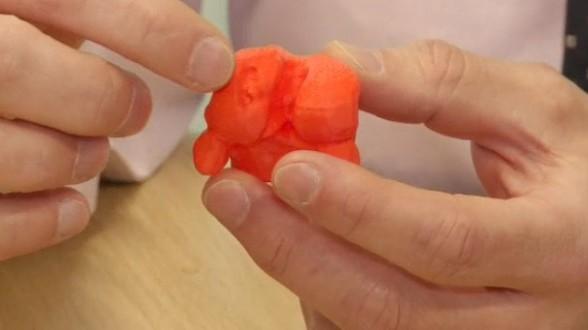3D scanning and printing technologies are making enormous contributions to both the practice and study of medicine and this is no less true of veterinary medicine than any other area. Recently, Dr. Matthew Allen, professor of Small Animal Surgery at the University of Cambridge, was able to reap the benefits of these advanced manufacturing methods when dealing with a patient named Bella who had a damaged knee joint.
 Bella is a Romanian Bucovina Shepherd, a large rustic dog whose breed has traditionally worked side by side for centuries with Romanian shepherds. In Bella’s case, however, her most important job was being a loving companion, something at which she excels. Unfortunately, she suffered from mobility problems as a result of a damaged knee joint and in order to maintain her quality of life, it was determined that she needed to undergo surgery. Luck was on her side in the form of Dr. Allen who believed that 3D printing might provide a less traumatic surgery with better results.
Bella is a Romanian Bucovina Shepherd, a large rustic dog whose breed has traditionally worked side by side for centuries with Romanian shepherds. In Bella’s case, however, her most important job was being a loving companion, something at which she excels. Unfortunately, she suffered from mobility problems as a result of a damaged knee joint and in order to maintain her quality of life, it was determined that she needed to undergo surgery. Luck was on her side in the form of Dr. Allen who believed that 3D printing might provide a less traumatic surgery with better results.
 Because the bone in Bella’s knee was only partially damaged, the result of a disease when she was young, Dr. Allen decided it might not be necessary to replace the entire joint. In order to understand how much of it needed to be removed and what could be left in place, he first created a series of 3D models of Bella’s knee. He used the CT scan data to create the virtual model in Materialise Mimics and had the print produced at the University of Cambridge.
Because the bone in Bella’s knee was only partially damaged, the result of a disease when she was young, Dr. Allen decided it might not be necessary to replace the entire joint. In order to understand how much of it needed to be removed and what could be left in place, he first created a series of 3D models of Bella’s knee. He used the CT scan data to create the virtual model in Materialise Mimics and had the print produced at the University of Cambridge.
Being able to examine the joint in detail prior to the surgery gave Dr. Allen a leg up when the time came to undertake the operation. In addition, a 3D printed surgical guide was created to be placed on the bone during the operation that directed him exactly where the cuts to the bone were to be made. The implant itself was created using traditional methods by the American company BioMedtrix but the 3D print provided the input necessary to create it. Thus advanced manufacturing technology played a vital role in optimizing this surgical intervention and this represents the first time that 3D printed guides have been used in a partial knee replacement surgery on a dog.
 The surgery was a success and Bella’s owner, herself a veterinarian, reports that there has been a significant improvement in Bella’s mobility. From being nearly unable to move around, she is now able walk around and get back to enjoying all of the sniffing and snuggling that a dog could hope for. Discuss further over in the 3D Printing Aids in Canine Knee Replacement forum at 3DPB.com.
The surgery was a success and Bella’s owner, herself a veterinarian, reports that there has been a significant improvement in Bella’s mobility. From being nearly unable to move around, she is now able walk around and get back to enjoying all of the sniffing and snuggling that a dog could hope for. Discuss further over in the 3D Printing Aids in Canine Knee Replacement forum at 3DPB.com.
Subscribe to Our Email Newsletter
Stay up-to-date on all the latest news from the 3D printing industry and receive information and offers from third party vendors.
Print Services
Upload your 3D Models and get them printed quickly and efficiently.
You May Also Like
3D Printing News Briefs, July 2, 2025: Copper Alloys, Defense Manufacturing, & More
We’re starting off with metals in today’s 3D Printing News Briefs, as Farsoon has unveiled a large-scale AM solution for copper alloys, and Meltio used its wire-laser metal solution to...
Etsy Design Rule Change Reduces Selection of 3D Printed Goods
Online marketplace Etsy has implemented a rule change requiring all 3D printed goods on the site to be original designs. The update to the site’s Creativity Standards states, ¨Items produced using...
Siraya Tech Introduces New Elastomer 3D Printing Materials, Including Foaming TPU
California company Siraya Tech, founded in 2019 with a focus on material science, customer focus, and agility, develops high-quality 3D printing materials that meet the needs of creators, hobbyists, and...
3D Printing News Briefs, April 12, 2025: RAPID Roundup
The news from last week’s RAPID+TCT in Detroit just keeps on coming! That’s why today’s 3D Printing News Briefs is another RAPID Roundup of more exciting announcements from the trade...

































